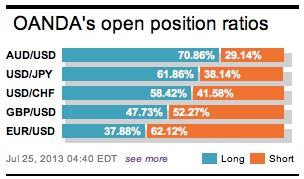Finally, investor’s got a plethora of data to sift through in the Euro session this morning. They were all hoping to find that winning fundamental direction. Cable had growth data to contend with while the ‘single’ currency is currently being influenced by German and Italian business and consumer confidence and the Euro money supply data. It seems that both the EUR and GBP were stopped in their progressive tracks and this despite the daily momentum for both currency pairs remaining positive.
UK economic growth accelerated in Q2 (+0.6%) as all sectors expanded for the first time in three-years. Economic output was +1.4% higher compared to the same period of last year – the data was very much in line with consensus. However, the British Isles economic output remains -3.3% below its pre-crisis peak and output has grown only +2.1% since the coalition government came to power three-years ago. The economy still faces many challenges, particularly the “squeeze on household incomes as wages fail to keep up with price increases.” PM Cameron’s ongoing austerity measures, restrictive credit conditions and fragile global growth, the same concerns that all the Euro peripheries face, will likely continue to weigh on any country’s prospects. The UK services sector was again the main drive of growth. Despite making up +78% of total economic output, growth grew +0.6%.

Sterling traders did what was needed – they actually sold cable on the back of ‘buy the rumor sell the fact’ as they were actually disappointed by the UK’s GDP print. Technical traders expect GBP to be underpinned in the upper 1.52’s as the UK data was decent (more bullish PMI’s expected) and the Euro-zone data still has some soft spots (loans, and M3). Market attention will now shift to the BoE MPC meeting next week and more importantly the BoE Quarterly Inflation Report. These events could turn what many expect to be a quiet August into a more volatile event risk date.
German business confidence rose further in July (106.2 from 105.9), beating market consensus for the third-consecutive month. The headline will come as a relief to many, especially after Germany, the backbone of Europe, barely grew in Q1. Rising consumer and business sentiment indicate that economic growth will accelerate in H2. Analysts are expecting yearly Euro growth to come in around +0.5%. Despite the data being mostly in line with forecasts, recent hard data would still suggest that Euro growth would be slow.

Stealing the German Ifo thunder was the Euro M3 data (broad gauge of money supply). If there was a monetary rational for the ECB to deliver more stimulus there is no better place than looking at this mornings Euro money supply data. M3 has slowed to +2.3% in June, a sharp deceleration from market consensus of +3%. Loans to the private sector fell -1.6% – analysts not that this shows how the “transmission mechanism within the Euro framework is still broken.” Money is not flowing freely and there is not enough of it. Technically, it is still been held up in the wrong places. The problem is that the ECB hawks will look at the Euro PMI’s and will vote for no further stimuli or easing of policy. The financial institutions believe that the economic situation in the peripheries especially is a bad bet to lend. It’s a vicious circle – more credit needs to be extended to finance spending and consumption and in time new jobs and without it leads to stagnation.
Not all the Euro-periphery nations are wallowing. Italian consumer confidence hit its highest level in a year this month (97.3), as household’s optimism about economic outlook improved. Europe’s third largest economy increase was due to a rise in confidence about the broader economic climate (94.6 vs. 91.8), which helped to drive the overall reading. The 17-member single currency paid no heed to the Italian data.

The EUR was bid up on strong Euro PMI prints yesterday, and has since sold off on higher US yields. The theme for this summer is to watch the bund-Tsy spread for market direction. Investors were looking for bullish news from German Ifo data – they barely got it, and combined with the weak Euro money supply data kick started the ‘buy the rumor and sell the fact’ trade. EUR stop-losses below 1.32 have already been triggered this morning. The most noticeable element whilst Europe hands over trading responsibilities to North American dealers is that this morning’s moves have occurred at a relative “snails” pace. This would suggest that with a lack of momentum, volatility could remain suppressed. Let’s hope that the month of August does not shut down entirely. There is event risk – FOMC, NFP, BoE inflation, etc., etc. and that is only in the first two weeks.

Other Links:
EUR Bid Tone Supported By PMI’s, For Now
Dean Popplewell, Director of Currency Analysis and Research @ OANDA MarketPulseFX
This article is for general information purposes only. It is not investment advice or a solution to buy or sell securities. Opinions are the authors; not necessarily that of OANDA Corporation or any of its affiliates, subsidiaries, officers or directors. Leveraged trading is high risk and not suitable for all. You could lose all of your deposited funds.



